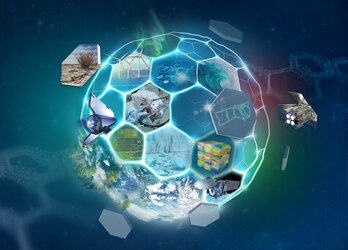About Materials and Processes
Assembling a satellite is no ordinary task, and it is one that requires far from ordinary building materials. The various parts making it up will have to endure an environment like nothing on Earth combining high vacuum, extreme temperatures and aggressive radiations, and engineers need to be certain of which materials they can rely on when designing for such a hostile environment.
What is Materials and Processes?
Materials and Processes activities include rigorous testing to assess how individual materials respond to harmful factors of the space environment. Detailed space simulations are carried out and the physical characteristics of materials and parts are precisely characterised. Lists are maintained of approved materials together with details of their precise physical and chemical properties, to be made available to mission teams.
Another element of the work done is failure analysis. Spacecraft components undergo rigorous testing long in advance of their mission launch. If and when a failure does occur the aim is to understand why it took place and find ways of preventing it next time around. A wide range of equipment is available for this task including scanning electron microscopes and acoustic microscopes for non-destructive examinations.
On the Processes side, preferred manufacturing and assembly methods are established based on continual research and testing to minimise the chance of material or component failure, these procedures going on to form ESA and European production standards.
Soldering remains a vital skill within satellite assembly, and regular courses are run in the subject for space industry firms by a European network of soldering schools. Companies are also evaluated on their techniques of circuit board engineering and surface mounting of components. Once qualified, a company is then added to a recommended list of ESA suppliers.
ESA also evaluates other manufacturing methods including clean room procedures with the aim of reducing contamination on a spacecraft to an absolute minimum. Air filters limit airborne dust but human workers are the single largest source of contamination due to shedding of hair and skin, so clean room protocols must include rigorous training.
Even then some particulates will still get through, so the spacecraft must be cleaned without inadvertently contributing to contamination. Tests on spacecraft cleanliness are carried out even up to the verge of launch from Kourou and other sites.
Why is Materials and Processes important?
During its life, a satellite is confronted to many aggressive environments including the ones on ground like corrosion and ageing.
During launch a satellite is exposed to high levels of acoustic noise, vibration and transitory G forces, potentially causing stress corrosion in susceptible alloys or composites. Pyrotechnic shocks are also triggered as secured satellite elements such as antennas are deployed once in orbit.
Once in orbit the single most violent part of a satellite's career is over and done with, but the space environment is far from welcoming. A satellite in low-Earth orbit passes from day into night many times a day. This 'thermal cycling' triggers abrupt temperature changes with can induce thermal stress, vibration and cracking.
Ultraviolet radiation in unfiltered sunlight as well as atomic oxygen particles may crack susceptible plastics and coatings. Optical surfaces and integrated circuits have to resist the onslaught of ionised radiation and charged particles as well as UV, while prolonged vacuum exposure can lead to materials outgassing – the same phenomenon that causes new car interiors to smell – threatening harmful contamination on delicate instrument surfaces as these unwanted substances condense.
But the deep knowledge of materials and manufacturing applied by the Materials and Processes domain offers means of limiting a spacecraft's vulnerability to these malign effects.
What innovations are involved?
Extensive testing is being undertaken to assess new materials being considered for space, such as unusual alloys and polymer composites, vacuum lubricants and ceramic ingredients for heat shields. Such testing ends generally by destructive analysis highlighting the damaged and material modification induced by the space mission environment. Other laboratory tests assess the reliability of new assembly methods for circuit boards and other components.
New testing facilities are developed in support of new ESA programmes, such as high and low temperature vacuum chambers, reflecting future plans for missions to Mercury and Jupiter or toward the Sun.
In addition to the qualification of new materials, totally new developments in the domain is continuously on-going to enable new applications for next generation of materials in space. New materials are developed under a strong leadership of space community when they present a unique combination of properties that would benefit demanding applications. This has been the case e.g. for SiC (Silicon Carbide). Two processes have allowed making the Herschel 3.5 m diameter mirror, namely:
- The sintering of cold-pressed and machined powder (sintering temperature of more than 2000C for many hours)
- The brazing of the sintered SiC parts together (Herschel is composed of 12 petals joined all together in a single brazing cycle) The SiC material is more and more widely used for space and non-space applications where lightness, stiffness and dimensional stability are required.
For the next generation of space missions, nano technology is seen as key enabling technology to increase spacecraft performance. For example new coatings and reinforced structural materials will be the basic building blocks of the next generation spacecraft.
Highly accurate test methods are developed in parallel to new materials to verify that they possess indeed the unique set of properties allowing fulfilling the requirements of specific missions.
What applications and missions are being enabled?
Each and every ESA spacecraft's materials and components will have been through exhaustive Materials and Processes testing and documentation. In the field of human spaceflight in particular, all items destined to be flown to the International Space Station must undergo mandatory flammability and toxicity testing.















 Germany
Germany
 Austria
Austria
 Belgium
Belgium
 Denmark
Denmark
 Spain
Spain
 Estonia
Estonia
 Finland
Finland
 France
France
 Greece
Greece
 Hungary
Hungary
 Ireland
Ireland
 Italy
Italy
 Luxembourg
Luxembourg
 Norway
Norway
 The Netherlands
The Netherlands
 Poland
Poland
 Portugal
Portugal
 Czechia
Czechia
 Romania
Romania
 United Kingdom
United Kingdom
 Slovenia
Slovenia
 Sweden
Sweden
 Switzerland
Switzerland

























